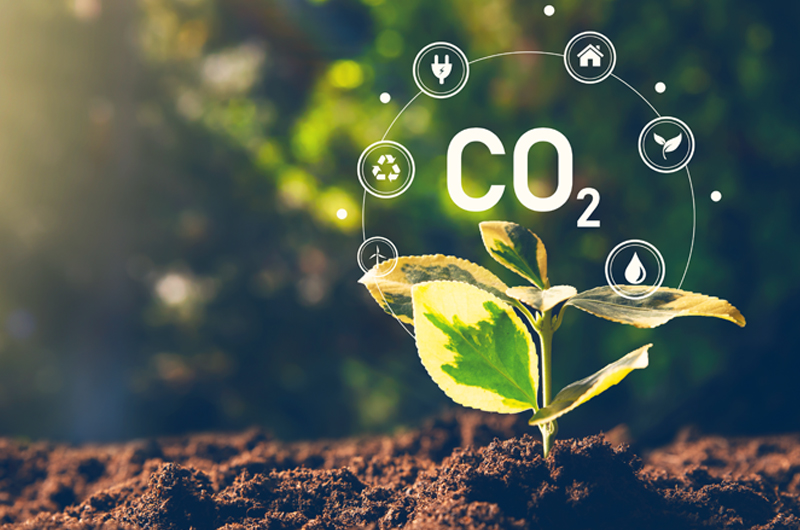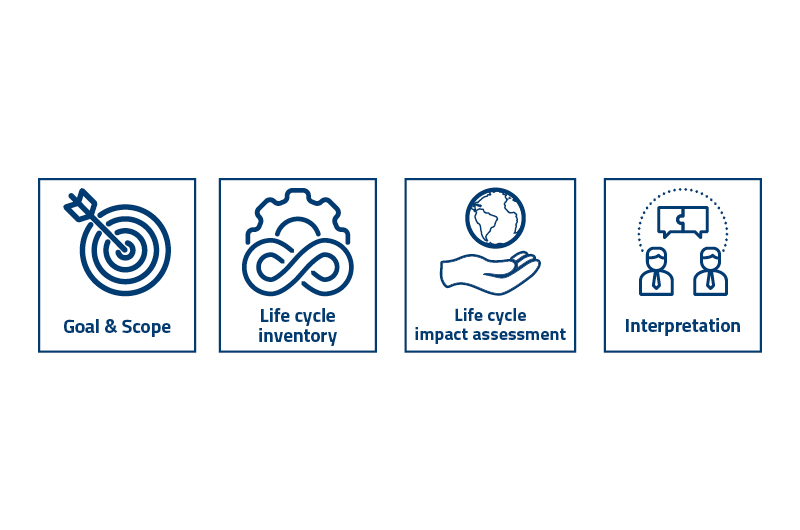
A PRACTICAL GUIDE TO UNDERSTANDING A LIFECYCLE ASSESSMENT FOR YOUR BUSINESS
A Life Cycle Assessment (LCA) is a systematic analysis that evaluates the environmental aspects and potential impacts of a product, process, or service throughout its life cycle. From raw material extraction through materials processing, manufacturing, distribution, retail and use, repair and maintenance, to disposal and recycling, an LCA aims to comprehensively assess a product’s environmental footprint.
Life cycle assessments enable a company to identify, for example, how two distinct manufacturing methods for the same product stack up against each other in terms of sustainability performance, the advantages of making changes to technologies and processes, and which stages of a product’s lifecycle contribute the most to environmental impact, such as greenhouse gas emissions.
Let’s look into the world of LCAs, how LCAs are conducted and the benefits of LCA reporting.

WHY DO COMPANIES CONDUCT LIFE CYCLE ASSESSMENTS?
Companies conduct Life Cycle Assessments (LCAs) for a variety of reasons, many of which are tied to environmental, social, and governance (ESG) goals, as well as business and strategic considerations. There are many benefits to conducting LCAs in a business.
For one, LCAs help companies make more informed decisions, that can ultimately avoid rebound effects and putting efforts on less efficient solutions. Life cycle assessments offer a data-driven basis for understanding current environmental performance. LCAs highlight potential inefficiencies in resource utilization and waste production. These insights guide the C-Suite and teams in improving product/service development, material sourcing, processes and end-of-life management, making supply chains more efficient and sustainable.
Secondly, certain industries and countries mandate sustainability reporting or adherence to specific environmental standards. Whether it’s the Greenhouse Gas (GHG) Protocol, the EU’s upcoming Digital Product Passport (DPP), certification credits for (think: BREEAM or LEED), or a range of other regulations, LCAs support compliance and reporting processes.
WHAT ARE THE DIFFERENT LIFE CYCLE MODELS?
There are four main life cycle models:
Cradle to grave: This model considers the entire lifecycle of a product or process from raw material extraction (the cradle) to the disposal of the product (the grave). It includes every stage. For example, in the case of an aluminium can, a cradle-to-grave assessment would include everything from the extraction of minerals to being sent to a recycling center.
Cradle to gate: This model is a partial lifecycle assessment that starts with extracting raw materials (the cradle) and ends once the product leaves the manufacturer (the gate). It includes stages like raw material acquisition, processing, and manufacturing but excludes distribution, use, and disposal. An example would be assessing the impacts of making furniture until it leaves the manufacturer. This assessment does not include its transportation, use, or eventual disposal.
Cradle to cradle: This lifecycle model considers a product’s entire life cycle from raw material extraction to the end of the product’s life—and how it is revalorized. Instead of ending with disposal, the product is designed to be recycled or reused somehow, thus returning to the “cradle.” The goal is to create a circular, waste-free product lifecycle. In the case of a cradle-to-cradle model, an EV battery could be reused for applications that require lower performance levels or be recycled for its precious minerals.
Gate to gate: This is another partial life cycle model that only considers one life cycle stage, usually within a single company. It might cover the environmental impact of just one step in the manufacturing process, like the emissions from making food products, but not factor in the cultivation and transportation of ingredients.
Each of these models serves different purposes and provides different types of information. The choice of which one to use depends on a company’s LCA goals and its boundaries for reporting.

IS THERE AN OFFICIAL FRAMEWORK FOR CONDUCTING LIFE
CYCLE ASSESSMENTS?
The International Organization for Standardization (ISO) has developed ISO 14040:2006, which defines the standardized framework for conducting LCAs. ISO 14040:2006 includes four phases of a life cycle assessment: goal and scope, life cycle inventory analysis (LCI), life cycle impact assessment (LCIA), and life cycle interpretation. We will describe these in more detail below.
Remember that ISO only develops the ISO 14040:2006 standard; it does not certify organizations for LCA compliance
WHAT ARE THE PHASES OF A LIFE CYCLE ASSESSMENT?
The four phases of a life cycle assessment are very much intertwined, with each one affecting the accuracy of the one coming after it. The first phase defines the LCA’s goal and scope: what will the company assess and not assess, which of the 15 environmental impact categories will the assessment focus on, and what data is required. Here is a high-level example, a running shoe manufacturer wants to make more sustainable products by reducing GHG emissions during their lifecycle. The manufacturer decides to analyze its entire shoe production from cradle to crave. Therefore, Its LCA evaluates the GHG emissions generated by one pair of running shoes. Once completed, the LCA will be the base year for reporting GHG emissions with the GHG Protocol and determining ways to boost the sustainability of the supply chain.
Life cycle inventory analysis (LCI) is the data collection phase. It quantifies the environmental inputs and outputs of the pair of shoes, such as the raw materials, types of energy and water that are used to make the product. LCI is also comprised of the GHG emissions and other environmental impacts the shoes have on the land, air or water. Input and output data can be gathered internally through energy bills and the like. Emissions data can be collected via research or government organizations.
The life cycle impact assessment (LCIA) is the third phase of an LCA. This phase tabulates inventory data with specific environmental impact categories, including global warming potential, natural resource depletion, stratospheric ozone depletion, acidification, photochemical ozone creation, eutrophication, and human and aquatic toxicity, to name a few. The goal is to model the raw LCI data into potential damage to the ecosystems, human health, and resources.
The final phase of a life cycle assessment is the interpretation stage. All the data and results collected during the previous phases are analyzed and evaluated to assess them based on the initial scope and goal. Data accuracy and consistency checks are also performed. The goal is to draw conclusions and provide recommendations for continuous improvement and environmental impact reduction.

WHAT ARE THE LIMITATIONS OF LCA?
While LCAs are useful for building the foundation of strategic decisions to optimize environmental performance, there are nevertheless some limitations.
- Data availability and recency: Gathering reliable, accurate and up-to-date data for every phase of a product/service/process life cycle can be challenging and time-consuming. Some databases only have data from several years ago or averages and samples, which do not reflect today’s reality.
- Local impact is not addressed: LCAs measure global and regional impact, rather than local environmental effects. This means a product or service could have very little effect globally—but a significantly detrimental impact on local populations and ecosystems.
- The breadth of impact measurement: For now, the LCA framework is focused on the environmental aspects of a product, service or process. It does not yet fully zero in on the social implications and economic factors, like working conditions, gender equality, socio-economic ripple effects on local communities, human rights, working conditions, etc. However, work is being carried out to expand LCA forms to include these aspects.
WHAT DOES A LIFE CYCLE ASSESSMENT REPORT LOOK LIKE?
An LCA is a detailed report that is comprised of an executive summary, the detailed findings of each phase of the life cycle assessment, the interpretation and concrete recommendations, and an appendix that includes the data and analysis methodology. The exact format and contents will depend on the audience and intended use of the LCA. Not all LCAs are made to be public, for example. If the report will be available for a larger public, some companies choose to exclude sections that are used only internally.
That being said, here are some examples of life cycle assessment reports you can peruse to see the tangible output:
- LCA of the environmental performance of materials in roofing systems
- LCA of the lifetime carbon footprint of a vehicle
- LCA of carton packages for EU markets
- LCA for PET-bottle recycling in Brazil
The report will be used for various purposes depending on the study’s goals. On top of strategic business decisions, an LCA can guide product development, support environmental claims in marketing, or be submitted to regulators to demonstrate compliance with regulatory standards.
LCAs offer a comprehensive and structured approach to understanding the ecological ramifications of products, services and processes, shedding light on the hidden environmental costs. With looming regulations around the world and the climate crisis that shows no signs of abating any time soon, companies of all sizes must consider incorporating life cycle thinking (LCT) in their vision for the future—for their businesses and the planet.
Interested in learning more about how OPTEL can transform the complexity of LCA processes into a manageable, step-by-step approach?
Related Blog Post

5 Ways in Which Traceability Ensures a More Certain and Sustainable World
OPTEL invites you to discover the 5 reasons for advantages of digital traceability

EU Corporate Sustainability Reporting Directive
The Corporate Sustainability Reporting Directive (CSRD) was published in the the Official Journal of the European Union on December 16, 2022. It requires certain companies to provide reports on sustainability-related matters, in line with a set of standards.

What Are Scope 3 Emissions?
“Scope 3 emissions are the result of activities from assets not owned or controlled by the reporting organization, but that the organization indirectly affects in its value chain” (EPA, 2023).
